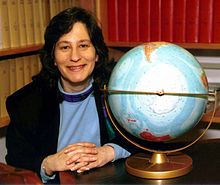Susan Solomon
Susan Solomon | |
|---|---|
 Susan Solomon | |
| Born | 1956 |
| Citizenship | United States |
| Alma mater | B.S. Illinois Institute of Technology, Ph.D. University of California, Berkeley |
| Known for | Ozone Studies |
| Awards | National Medal of Science |
| Scientific career | |
| Fields | Atmospheric Chemistry |
| Institutions | National Oceanic and Atmospheric Administration |
Susan Solomon (born 1956 in Chicago)[1] is an atmospheric chemist working for the National Oceanic and Atmospheric Administration.[2] Solomon was one of the first to propose chlorofluorocarbons as the cause of the Antarctic ozone hole.[2]
Solomon is a member of the U.S. National Academy of Sciences, the European Academy of Sciences, and the Academy of Sciences of France.[3]
Biography
Early life
Solomon began her interest in science as a child watching The Undersea World of Jacques Cousteau.[1] In high school she placed third in a national science fair, with a project that measured the percent of oxygen in a gas mixture.[1]
Solomon studied Chemistry at the Illinois Institute of Technology, receiving her B.S. in 1977.[4] She received her Ph.D. in chemistry from the University of California, Berkeley in 1981, where she specialized in atmospheric chemistry.[4]
Marriage
Solomon married Barry Sidwell in 1988.[1]
Work
Solomon is the head of the Chemistry and Climate Processes Group of the National Oceanic and Atmospheric Administration Chemical Sciences Division.
Books
The Coldest March: Scott's Fatal Antarctic Expedition - Depicts the tale of Captain Robert Falcon Scott's failed 1912 Antarctic expedition.
The ozone hole
Solomon was chosen to lead the National Ozone Expedition to McMurdo Sound in Antarctica to investigate the hole in the ozone layer in 1986 and another in 1987.[2] Her team discovered higher levels of chlorine oxide than expected in the atmosphere, which had been released by the chlorofluorocarbons.[4]
Solomon also showed that volcanoes could accelerate the reactions caused by chlorofluorocarbons, and so increase the damage to the ozone layer.[4] Her work formed the basis of the U.N. Montreal Protocol, an international agreement to protect the ozone layer by regulating damaging chemicals.[1]
Intergovernmental Panel on Climate Change
Solomon served as one of the co-chairs of Working Group 1 of the Intergovernmental Panel on Climate Change.[2]
Awards
- 2007 - Nobel Peace Prize - On the Intergovernmental Panel on Climate Change (IPCC).
- The IPCC shared the Nobel Peace Prize with Al Gore, Jr.
- 2004 - Blue Planet Prize[1]
- 1999 - National Medal of Science[4]
- 1994 - Antarctic glacier named in her honor
References
- ^ a b c d e f "What's Up With Ozone?". Women In Chemistry. Chemical Heritage Foundation. Retrieved 2007-02-20.
- ^ a b c d "InterViews". National Academy of Sciences. 2004-07-26. Retrieved 2007-02-20.
- ^ "Susan Solomon: Pioneering Atmospheric Scientist". Top Tens: History Makers. National Oceanic and Atmospheric Administration. 2007-01-05. Retrieved 2007-02-20.
- ^ a b c d e "Meet Susan Solomon". Faces in the Environment. Chemical Heritage Foundation. 2001. Retrieved 2007-02-20.
